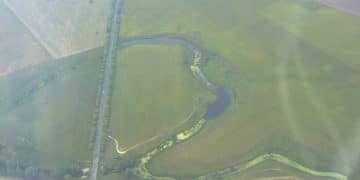ESA Amendments: A Landowner’s Guide to Protected Species

The latest amendments to the Endangered Species Act introduce significant changes for US landowners, impacting land use, development, and conservation responsibilities, necessitating a clear understanding of compliance and stewardship.
For many US landowners, the Endangered Species Act (ESA) can often feel like a complex and formidable piece of legislation, a labyrinth of regulations impacting property use and development. The recent amendments have only added layers to this complexity, making it crucial for every landowner to grasp the implications. This guide aims to demystify these changes, offering an accessible and practical understanding of the latest amendments to the Endangered Species Act for US landowners, detailing how these updates might shape your operations and conservation efforts on your land. Understanding these shifts is not just about compliance; it’s about informed stewardship and proactive engagement with the ecological landscape you manage.
The foundational principles of the ESA and its evolution
The Endangered Species Act of 1973 stands as one of the most comprehensive legislative frameworks for biodiversity conservation globally. Its core purpose is to protect and recover imperiled species and the ecosystems upon which they depend. This foundational act categorizes species as either “endangered” (in danger of extinction throughout all or a significant portion of its range) or “threatened” (likely to become endangered in the foreseeable future). The ESA’s scope extends beyond charismatic megafauna to include plants, insects, and microorganisms, recognizing that all components of an ecosystem are interconnected and vital for its health.
Underlying the ESA are several key principles that guide its implementation. Firstly, it emphasizes the preservation of ecosystems, acknowledging that species recovery inherently relies on healthy habitats. Secondly, it mandates the development of recovery plans for listed species, outlining specific actions needed to bring a species back from the brink of extinction. These plans often involvehabitat restoration, captive breeding programs, and public awareness campaigns. Thirdly, the ESA imposes strict prohibitions on the “take” of listed species, which includes not only direct harm but also habitat modification that might injure a species. This broad definition of “take” is particularly significant for landowners, as it can influence land management practices. Over the decades, the ESA has demonstrated considerable success, leading to the recovery of species like the bald eagle and the American peregrine falcon. However, its implementation has also faced ongoing challenges, sparking debates over property rights, economic impacts, and the balance between conservation and development.
The ESA’s Journey: Key Milestones and Debates
Since its inception, the ESA has undergone several significant administrative and judicial interpretations, though major legislative amendments have been less frequent. Early interpretations focused heavily on preventing direct harm, but later court rulings expanded the concept of “take” to include habitat destruction. This evolution prompted greater attention to land-use planning and conservation easements.
* Habitat Conservation Plans (HCPs): Introduced in 1982, HCPs provide a mechanism for landowners to undertake activities that might incidentally “take” a listed species, provided they mitigate the impacts and contribute to the species’ recovery. These plans represent a critical tool for balancing development with conservation.
* Critical Habitat Designation: The ESA also allows for the designation of “critical habitat,” areas essential for the conservation of a listed species. This designation can carry regulatory implications for federal projects and, indirectly, for private landowners whose activities require federal permits or funding.
* “Darkwood” Issues: A persistent challenge has been the “darkwood” effect, where landowners avoid managing their land in ways that might attract or benefit endangered species, fearing future restrictions. This challenge underscores the need for incentives and collaborative approaches to conservation.
These continuous dialogues and refinements have shaped the ESA into a dynamic, rather than static, piece of legislation. Its evolution reflects both scientific progress in understanding biodiversity and ongoing societal efforts to balance conservation imperatives with economic and social needs. The recent amendments continue this trajectory, aiming to refine certain aspects of implementation to better achieve the Act’s goals while addressing practical concerns of stakeholders, particularly landowners.
Understanding the recent amendments: What has changed?
The recent amendments to the Endangered Species Act represent a significant realignment of several key definitions and processes, particularly those concerning how species are listed, how critical habitats are designated, and how regulatory impacts are considered. These changes aim to enhance efficiency and provide greater clarity for all stakeholders, including US landowners, who often bear the direct consequences of these regulations. It’s crucial for landowners to understand the subtleties of these adjustments, as they can directly influence land management practices, development opportunities, and conservation responsibilities.
One of the most consequential changes revolves around the listing process for species. Previously, the determination of whether a species was “endangered” or “threatened” was made solely on the basis of scientific and commercial data, without considering economic impacts. The new amendments introduce provisions that allow for the consideration of potential economic impacts when designating critical habitat, although the listing decision itself is still primarily science-driven. This shift has been a point of contention, with proponents arguing it brings a needed practical dimension to conservation decisions, while critics fear it could undermine the ESA’s core purpose by allowing economic factors to outweigh scientific necessity in habitat protection. For landowners, this could mean that critical habitat designations might be more precisely tailored to minimize economic disruption, or at least that economic impacts will be openly assessed during the designation process, potentially leading to more transparent and predictable outcomes.
Key Regulatory Adjustments and Their Implications
Beyond the listing process, several other regulatory adjustments have been implemented, each with direct implications for landowners:
* “Threatened” Species Protections: Prior amendments automatically extended the same protections to “threatened” species as “endangered” species, known as the “blanket rule.” The recent changes remove this automatic application, allowing federal agencies to tailor specific protections for threatened species on a case-by-case basis. This provides greater flexibility, potentially reducing the regulatory burden on landowners for species deemed less immediately imperiled. Landowners might find more nuanced regulations applied to their property, depending on the specific characteristics of the threatened species present.
* Interagency Cooperation and Consultation: The amendments also refine processes for interagency cooperation and consultation under Section 7 of the ESA, which requires federal agencies to ensure that their actions do not jeopardize listed species or destroy their critical habitat. The aim is to streamline these consultations, making them more efficient and predictable. For landowners undertaking projects that require federal permits or funding, this could translate into a faster and clearer review process, reducing delays and uncertainties associated with environmental compliance.
* Habitat Designation Criteria: While still science-driven, the criteria for designating critical habitat have been clarified, emphasizing areas that are truly “essential for conservation.” This could lead to more targeted designations, avoiding areas where the species’ presence is incidental or where conservation benefits are marginal. Such precision is intended to reduce the scope of regulated areas, potentially freeing up some land from certain restrictions.
These amendments collectively aim to inject more flexibility and practical considerations into the ESA, without fundamentally altering its protective mandate. They reflect a growing recognition that effective species conservation requires a balance between strict regulation and stakeholder engagement. For landowners, staying abreast of these detailed changes is crucial for informed decision-making regarding property management, development plans, and participation in voluntary conservation efforts. The implications are far-reaching, influencing everything from agricultural practices to residential construction in areas where listed species are present.

Impact on US landowners: Rights, responsibilities, and challenges
The recent amendments to the Endangered Species Act introduce a modified landscape for US landowners, reshaping their rights, responsibilities, and the challenges they might encounter. While the fundamental principles of private property rights remain enshrined, these legislative adjustments necessitate a re-evaluation of how landowners interact with conservation regulations. Understanding this evolving dynamic is paramount for effective land management and for avoiding potential legal pitfalls.
One of the direct impacts stems from the refined criteria for critical habitat designation and the nuanced approach to threatened species. With the potential for more targeted critical habitat designations and tailored protections for threatened species, landowners might find regulations to be less universally applied and more specific to the actual ecological needs of a species. This could alleviate some of the broader restrictions previously encountered, but it also demands a more precise understanding of which species are present on one’s land and what specific, tailored protections apply. For example, a landowner previously under a blanket regulation for a threatened species might now be subject to only specific, context-dependent rules, requiring careful assessment of their property’s ecological characteristics. This shift places a greater onus on landowners to proactively seek information about species on their property and to understand the specific, rather than generic, regulatory framework.
Navigating the Landowner’s Role: Key Considerations
The challenges for landowners under the amended ESA are multi-faceted, ranging from financial implications to operational adjustments.
* Increased Information Burden: Landowners might need to invest more in surveys or consultations to determine the presence of listed species and to understand the specific implications of new, tailored regulations. This can involve engaging environmental consultants or seeking guidance from federal and state agencies, adding potential costs and time to land management decisions.
* Financial Implications: While some amendments aim to reduce economic burdens, the consideration of economic impact in critical habitat designation is a complex issue. Landowners might face initial economic impacts from adapting practices to new regulations, or from potential restrictions on development. Conversely, there might be opportunities for financial incentives through conservation programs.
* Compliance and Enforcement: Despite the increased flexibility for threatened species, the core prohibitions against “take” for endangered species remain robust. Landowners must meticulously comply with these regulations to avoid penalties, which can include hefty fines and even imprisonment. Vigilance and proactive planning are essential to prevent inadvertent harm to protected species or their habitats.
Moreover, the changes emphasize cooperation and voluntary conservation. Federal agencies are encouraged to work more closely with landowners to achieve conservation goals, possibly through incentive-based programs or cooperative agreements. This shift can present opportunities for landowners to engage in conservation efforts that align with their land management objectives, potentially accessing financial or technical assistance. Such programs can turn a regulatory burden into a collaborative effort, fostering a sense of shared responsibility for biodiversity. However, these opportunities require landowners to be well-informed and actively engaged in dialogues with relevant agencies and conservation organizations. The impact on landowners is thus a dynamic interplay between regulatory shifts, individual stewardship, and the evolving possibilities for collaborative conservation.
Opportunities for landowners: Conservation programs and incentives
While the Endangered Species Act often evokes images of restrictions and limitations for landowners, the recent amendments, coupled with existing federal and state initiatives, also present a spectrum of valuable opportunities. These opportunities pivot around various conservation programs and financial incentives designed to encourage voluntary participation in habitat restoration and species protection. For a savvy landowner, understanding and leveraging these programs can transform potential regulatory burdens into pathways for sustainable land management, often with significant economic benefits.
One of the primary avenues for engagement is through the various programs offered by federal agencies such as the U.S. Fish and Wildlife Service (USFWS) and the Natural Resources Conservation Service (NRCS). These agencies administer a suite of programs that provide technical assistance, financial aid, and regulatory assurances for landowners who voluntarily undertake conservation activities on their property. For instance, the USFWS offers programs like the Partners for Fish and Wildlife Program, which provides financial and technical assistance to private landowners to restore fish and wildlife habitats on their land. Similarly, the NRCS implements programs such as the Environmental Quality Incentives Program (EQIP) and the Conservation Stewardship Program (CSP), which offer payments and support for implementing conservation practices that benefit both agriculture and wildlife.
Key Programs and How They Work
Landowners can explore a range of specific mechanisms designed to facilitate conservation and provide benefits:
* Habitat Conservation Plans (HCPs): While HCPs are regulatory tools, they also serve as a significant opportunity. For landowners whose activities might incidentally take a listed species, an approved HCP can provide long-term regulatory certainty and allow for otherwise prohibited activities, provided the plan includes measures to minimize and mitigate the impact. This allows for planned development alongside conservation.
* Safe Harbor Agreements (SHAs): SHAs are voluntary agreements between landowners and the USFWS wherein landowners agree to undertake conservation measures to benefit listed species on their property. In return, the USFWS provides assurances that the landowner will not be subject to additional ESA restrictions if their activities attract or increase the population of listed species above a baseline. This removes the “darkwood” disincentive, encouraging landowners to proactively manage for conservation.
* Candidate Conservation Agreements with Assurances (CCAAs): Similar to SHAs, CCAAs are designed for landowners who conserve *candidate* species (those proposed for listing but not yet officially listed). If a species later becomes listed, the landowner receives assurances that no additional regulatory burdens will be imposed beyond those agreed upon in the CCAA. This encourages proactive conservation before a species is officially listed.
Beyond these federal programs, many state wildlife agencies and non-governmental organizations also offer regional or local conservation initiatives, often tailored to specific ecosystems or species. These can include land trusts offering conservation easements, which provide financial compensation in exchange for voluntarily restricting certain land uses, thereby preserving habitat in perpetuity. Engaging with these opportunities can not only contribute to the broader goal of biodiversity conservation but also provide landowners with financial incentives, tax benefits, and enhanced property value through sustainable land stewardship. It transforms the ESA from a potentially intimidating regulation into a framework for collaborative environmental management.
Navigating regulatory compliance and avoiding pitfalls
For US landowners, understanding the nuances of Endangered Species Act compliance is not merely about adhering to legal requirements; it is about proactive risk management and responsible stewardship. The consequences of non-compliance can be severe, ranging from hefty fines to legal injunctions that halt development or land use activities. Therefore, a strategic approach to navigating these regulations, coupled with an awareness of common pitfalls, is essential for every landowner operating in areas where listed species or critical habitats may exist.
A fundamental aspect of compliance involves thorough due diligence. Before undertaking any significant land-changing activity – whether it’s construction, agricultural expansion, or timber harvesting – landowners should conduct an initial assessment of their property for the potential presence of listed species or designated critical habitat. This can involve reviewing publicly available maps and databases from the USFWS and state wildlife agencies, or engaging with environmental consultants who specialize in ESA compliance. Ignorance of a species’ presence is not a valid defense against a “take” violation, making proactive inquiry a critical first step. If a listed species or critical habitat is identified or suspected, the landowner should then determine if their proposed activities could constitute a “take” or adversely modify critical habitat. This analysis often requires expert biological assessment.
Preventing Violations: A Landowner’s Checklist
Several common pitfalls can lead to ESA violations, often inadvertently. Landowners can mitigate these risks by adopting a systematic approach:
* Ignorance of Law and Species Presence: Many violations occur because landowners are unaware of the ESA’s prohibitions or fail to identify protected species on their property. Regular checks of federal and state listed species lists relevant to their geographic area are crucial.
* Proceeding Without Consultation: If a federal nexus exists (e.g., a project requires a federal permit, funding, or involves federal land), landowners must engage in formal consultation with the USFWS or NOAA Fisheries. Skipping this step can lead to significant delays and enforcement actions. Even without a federal nexus, consulting with agencies for guidance is a best practice.
* Inadequate Planning for Mitigation: For projects that may result in incidental take, an approved Habitat Conservation Plan (HCP) is necessary. Failing to develop a robust HCP or to adhere to its terms can render a project non-compliant. Mitigation measures must be effective and properly implemented.
* Altering Habitat Before Surveys: Some landowners inadvertently destroy habitat or displace species by clearing land without prior surveys. This can constitute an illegal “take” even if the species itself is not directly harmed. Early planning and biological surveys are key.
* Assuming State Regulations are Sufficient: While state endangered species laws exist, they do not supersede the federal ESA. Landowners must comply with both federal and applicable state regulations, as state laws can sometimes be more stringent.
Engaging legal counsel with expertise in environmental law and land use can further safeguard landowners, helping them to interpret complex regulations, negotiate with agencies, and develop robust compliance strategies. Ultimately, responsible land management under the ESA is a balancing act that requires a combination of vigilance, informed decision-making, and often, collaboration with regulatory bodies and conservation experts. By adhering to these principles, landowners can minimize their legal exposure and contribute effectively to species conservation.
The future of the ESA: Trends and predictions for landowners
The Endangered Species Act has always been a dynamic piece of legislation, subject to evolving scientific understanding, political climates, and societal expectations. For US landowners, peering into the future of the ESA is not merely an academic exercise; it’s a practical necessity for long-term planning, investment decisions, and land stewardship. Several emerging trends and predictions suggest how the ESA might continue to evolve, shaping the regulatory landscape for private property owners in the coming years.
One significant trend points towards an increased emphasis on proactive, landscape-scale conservation efforts. Rather than solely reacting to species on the brink of extinction, there’s a growing recognition that early intervention, often across broad geographical areas, can prevent species from needing ESA listing in the first place. This approach could lead to more incentive-based programs, collaborative conservation easements, and regional partnerships involving multiple landowners, conservation groups, and government agencies. For landowners, this might mean more opportunities to participate in voluntary agreements that offer benefits for early conservation actions, potentially before strict regulations are imposed. This shift aligns with the idea that “an ounce of prevention is worth a pound of cure,” making conservation more palatable and effective.
Predictive Insights for Landowners
Several factors will likely shape the ESA’s trajectory and its implications for landowners:
* Climate Change Integration: As climate change impacts biodiversity, the ESA’s framework will increasingly need to adapt. This could lead to new listing criteria that consider climate vulnerability, or the designation of critical habitats that anticipate future climatic shifts. Landowners might find themselves navigating regulations influenced by broader climate resilience goals, requiring flexibility in land use and management to accommodate species migration or habitat adaptation.
* Data-Driven Conservation: Advances in remote sensing, genomic sequencing, and data analytics will allow for more precise and localized conservation efforts. This precision could result in highly targeted critical habitat designations and more efficient monitoring of species populations. For landowners, this might mean more accurate assessments of their land’s ecological value and specific, rather than broad, conservation requirements.
* Increased Litigation and Political Debates: The ESA remains a focal point for environmental and property rights debates. Future amendments or judicial interpretations are likely to arise from legal challenges and legislative push-and-pull, particularly concerning the balance between conservation mandates and economic development. Landowners should anticipate ongoing policy discussions and potential shifts in regulatory emphasis.
* Stewardship Recognition and Market-Based Approaches: There’s a growing interest in rewarding landowners for their conservation efforts through market mechanisms, such as ecosystem service payments or conservation banking. While nascent, these approaches could become more widespread, offering landowners new revenue streams or economic benefits for providing vital ecological services like water quality improvement or carbon sequestration.
Ultimately, the future of the ESA for landowners will likely be characterized by a blend of ongoing regulatory vigilance and expanding opportunities for voluntary, collaborative conservation. Successful landowners will be those who remain informed, adapt proactively to evolving environmental policies, and explore the growing suite of incentives and partnerships available for sustainable land management. The journey of the ESA is far from over, and its continued evolution will require thoughtful engagement from all stakeholders, especially those who manage the landscapes critical to species survival.
Relevant sources for this section would include publications from environmental policy think tanks, academic journals focusing on conservation biology and environmental law, and official reports from federal agencies like the US Fish and Wildlife Service and the Department of the Interior. Discussions among leading environmental legal scholars and conservation practitioners also frequently highlight these thematic shifts.
Case studies: Real-world landowner experiences with the ESA
Understanding the theoretical aspects of the Endangered Species Act and its amendments is crucial, but real-world experiences often offer the most profound insights into its practical implications for landowners. Case studies illuminate the diverse challenges and opportunities that arise when conservation mandates intersect with private property rights and economic livelihoods. These narratives underscore the importance of proactive engagement, informed decision-making, and, at times, innovative solutions to navigate the complexities of species protection on private lands.
Consider the case of a large agricultural operation in the Pacific Northwest, where the listing of a local salmon species led to significant restrictions on water use and stream bank management. Initially, the landowners faced daunting challenges, including reduced irrigation capabilities and the sudden need for buffer zones along waterways, threatening their crop yields. Rather than pursuing contentious litigation, the family engaged with the U.S. Fish and Wildlife Service and local conservation groups. Through collaborative dialogue, they developed a Habitat Conservation Plan (HCP) that allowed them to implement a rotating fallow system for certain fields and to restore native riparian vegetation along the stream. In return, they received regulatory assurances, enabling them to continue their farming operations flexibly while contributing to salmon recovery. This case highlights how an initial conflict can transform into a successful partnership through adaptive management and mutual understanding.
Diverse Scenarios: From Conflict to Collaboration
Other scenarios illustrate a broader spectrum of landowner experiences:
* The Rancher and the Lesser Prairie-Chicken: In the Great Plains, efforts to conserve the Lesser Prairie-Chicken, a species that inhabits vast rangelands, initially caused concern among ranchers. Federal land managers worked with ranching communities to develop voluntary conservation agreements (like Candidate Conservation Agreements with Assurances). These agreements incentivized sustainable grazing practices that benefited both cattle and the chicken’s habitat, providing regulatory certainty to ranchers who adopted these ecologically sound methods. This demonstrated how financial and regulatory assurances can foster stewardship among private landowners.
* The Developer and the Karst Invertebrates: A developer in Central Texas faced a halt to a major housing project due to the discovery of rare, cave-dwelling invertebrates—a listed species—on the property boundary. The initial reaction was frustration and concern over project viability. However, through detailed biological surveys and extensive negotiation, the developer agreed to set aside a significant portion of the land as a permanent conservation easement, protecting the caves and their inhabitants. In exchange, the remaining land could proceed with development, albeit with modified plans. This case exemplifies the critical role of scientific assessment and compensatory mitigation in balancing development with protection.
* The Forest Landowner and the Northern Spotted Owl: In the past, timber harvesting on private lands in the Pacific Northwest was severely impacted by the listing of the Northern Spotted Owl. For many small private forest owners, this led to economic hardship. Over time, some landowners have explored alternative management strategies, such as engaging in conservation easements or participating in programs that provide technical assistance for ecosystem-based forestry. These approaches emphasize sustainable yields while maintaining habitat features beneficial to the owl, illustrating a shift towards integrating economic viability with ecological goals, rather than purely prohibitive measures.
These real-world examples portray the ESA not as a monolithic barrier, but as a living framework whose application depends heavily on specific ecological contexts, landowner engagement, and the willingness of all parties to seek common ground. They reveal that while challenges are inherent, there are also significant opportunities for innovation, collaboration, and mutually beneficial outcomes when landowners and conservation agencies work together. These stories are a testament to the fact that effective conservation on private lands often emerges from dialogue, flexibility, and a shared vision for healthy ecosystems.
| Key Aspect | Brief Description |
|---|---|
| 🌳 Critical Habitat | Economic impacts now considered in designation; aiming for more tailored areas. |
| ⚙️ Threatened Species | Protections for “threatened” species are no longer automatic; more flexibility. |
| 🤝 Conservation Programs | Enhanced opportunities for landowner incentives and voluntary agreements. |
| ⚖️ Compliance | Requires proactive due diligence & understanding of species-specific rules. |
Frequently asked questions about ESA amendments for landowners
▼
The main change is that economic impacts can now be considered when designating critical habitat. This means that while the science still drives the listing, the designation of specific areas might now take into account potential economic effects on landowners, aiming for more tailored approaches.
▼
No, the amendments removed the automatic “blanket rule” that extended the same protections to threatened species as endangered ones. Now, federal agencies can develop specific, tailored protections for threatened species on a case-by-case basis, potentially offering more flexibility for landowners.
▼
Landowners can consult publicly available maps and databases from the US Fish and Wildlife Service (USFWS) and state wildlife agencies. For more definitive information or before major land-use changes, hiring an environmental consultant to conduct a species survey is highly recommended to ensure accurate assessment.
▼
While not new incentives, the amendments reinforce the importance of voluntary conservation. Programs like Safe Harbor Agreements (SHAs) and Candidate Conservation Agreements with Assurances (CCAAs) offer regulatory certainty and potential financial benefits for landowners who proactively implement conservation measures, turning conservation into an opportunity rather than just a regulation.
▼
The biggest pitfall is proceeding with land-altering activities without proper due diligence or consultation. Ignorance of the law or the presence of a listed species is not a defense against an illegal “take.” Proactive assessment and engagement with regulatory bodies are crucial to avoid severe penalties and project delays.

Conclusion
The recent amendments to the Endangered Species Act represent a nuanced evolution rather than a revolutionary overhaul. For US landowners, understanding these changes is not merely an exercise in regulatory compliance but an opportunity for more informed and proactive land stewardship. The shifts in critical habitat designation, the tailored protections for threatened species, and the continued emphasis on voluntary conservation programs collectively aim to create a more flexible yet robust framework for species protection. While challenges remain, particularly in balancing property rights with ecological imperatives, the amendments also underscore the growing potential for collaborative solutions. Ultimately, the effective implementation of the ESA on private lands hinges on landowners remaining vigilant, seeking expert advice, and engaging constructively with the agencies and opportunities designed to support both economic viability and environmental health. The future of conservation in the United States increasingly depends on this informed and cooperative spirit.





